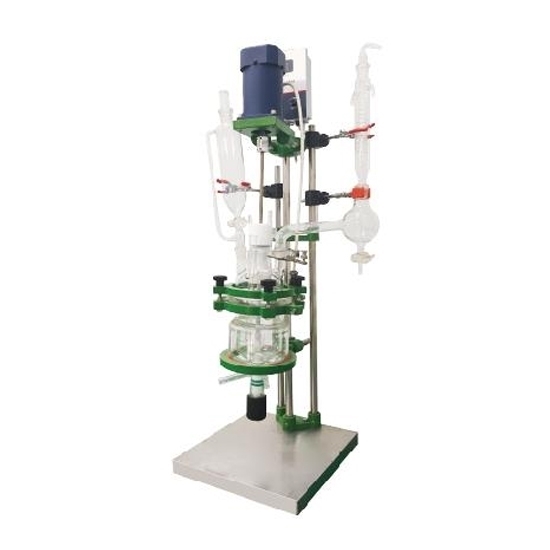
- Stock: In Stock
- Model: RDDLZ-JGR-5L
- Weight: 1.00
- SKU: RDDLZ-JGR-5L
Available Options
5L double jacketed glass reactor can be heated or cooled at constant temperature, and can also be vacuumed for negative pressure reaction. RDDLZ jacketed glass reactor is the ideal test and production equipment for the modern synthetic chemical, biopharmaceutical, and new material preparation.
Specification
| Model | RDDLZ-JGR-5 |
| Effective Volume in the Kettle | 5L |
| Condenser Heat Exchange Area | 2 m2 |
| Constant Pressure Funnel Volume | 0.2L |
| Recovery Head Volume | 0.5L |
| Glass Component Material | High borosilicate 3.3 |
| Main Frame Material | SUS304 |
| Working Temperature | -80~200°C |
| Pressure in Kettle | -0.098 Mpa |
| Stirring Motor Power | 90W |
| Speed Control Mode | Electronic speed control |
| Speed Adjustment Range | 0~1000 rpm |
| Seal Material | Fluorine rubber |
| Heating Method | Bath heating |
| Power Supply | 220V~240V |
| Frequency | 50/60HZ, 1P |
| Dimension | 1140*410*450mm |
| Weight | 61.5kg |
Features
- 5L jacketed glass reactor adopts new high borosilicate glass, which has excellent stability and corrosion resistance.
- Digital display frequency conversion speed control, stirring speed can be adjusted, and temperature control is accurate.
- Double jacketed glass reactor assembly adopts a fluorine rubber seal to maintain the high precision seal under working conditions.
- Modular design, easy to assemble, easy to upgrade and maintain.
- Stainless steel frame, good stability.
- Jacketed glass reactors can be customized according to customer requirements.
Applications
The glass-lined reactor finds application in various industries, serving as a versatile vessel for chemical reactions and processes due to its corrosion resistance and thermal stability. It is widely employed in the pharmaceutical, petrochemical, and food industries, among others.
Tips: What is the difference between a single layer glass reactor and a jacketed glass reactor?
A single-layer glass reactor and a jacketed glass reactor are both types of laboratory glassware used for chemical reactions, but they differ in design and functionality. Here's an overview of the differences between the two:
Structure:
- Single-layer glass reactor: As the name suggests, it consists of a single glass vessel that serves as the reaction chamber. It has a lid or cap for sealing the reactor.
- Jacketed glass reactor: It consists of two glass vessels—an inner glass vessel that serves as the reaction chamber and an outer jacketed glass vessel surrounding the inner vessel. The space between the two vessels is used to circulate a temperature-controlling fluid, such as water or oil.
Temperature control:
- Single-layer glass reactor: It typically lacks an external jacket for temperature control. Heating or cooling is usually achieved through an external heat source, such as a heating mantle or a water/oil bath. However, precise temperature control may be challenging in single-layer reactors.
- Jacketed glass reactor: The presence of the external jacket allows for efficient temperature control. The temperature- controlling fluid circulated through the jacket helps to maintain a stable and uniform temperature inside the reactor. This makes jacketed reactors suitable for reactions requiring precise temperature control.
Heat transfer:
- Single-layer glass reactor: Heat transfer occurs primarily through the glass walls of the reactor. However, the efficiency of heat transfer may be lower compared to a jacketed reactor.
- Jacketed glass reactor: The presence of the jacket enables efficient heat transfer due to the circulation of the temperature-controlling fluid. This facilitates rapid heating or cooling of the reaction mixture, leading to better temperature control and faster reaction rates.
Safety:
- Single-layer glass reactor: Since it lacks an external jacket, it may be more prone to temperature fluctuations, making it less suitable for reactions with stringent temperature requirements.
- Jacketed glass reactor: The jacket provides an additional layer of insulation and protection, reducing the risk of accidental burns and improving overall safety during high-temperature reactions.
